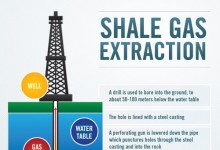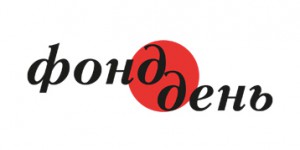Ukraine’s prospects as a result of exploration and production of shale gas could be compared to those of EU membership. The big difference is that Ukrainians have become aware of European integration as an all-round advantageous solution to their problems whereas the attitude to shale gas – rather, to the possible consequences of the existing extraction technologies – can hardly be described even as tolerant. Ukraine, along with other countries, is getting increasingly involved in a heated debate on whether a shale gas revolution is possible, whether it will benefit humankind, and most importantly, whether it will be safe.
The United States that has effectively carried out this revolution is urging other countries to follow suit. Ambassador John Tefft told a Ukrainian television channel that shale gas production would increase the competitiveness of Ukraine’s economy and create many jobs. The US shale gas revolution’s experience shows a decrease in the costs of steel, chemical components, and electricity. Above all, Tefft feels sure that the shale gas industry helps combat unemployment. Over the past several years more than 650,000 jobs have been created in the US – at the extraction facilities and in the related industries (steel and freight carrier companies, etc.). The same is true of the hotels and restaurants catering to the specialists engaged in the project.
Kurt Oswald, A.T. Kearney partner, studied the role of shale gas in the future of Europe and arrived at the conclusion that Ukraine stands every chance of turning from an importer to an exporter of gas. Recently he told a Ukrainian radio channel that by 2030, owing to their considerable shale gas deposits, Ukraine and Poland would find themselves in the lead on the European shale gas market; that this would become possible not only because of their rich deposits, but also owing to their leadership’s political will, and that the leaders of these countries should start developing this industry forthwith. Oswald stresses that the main positive consequence of shale gas production in Ukraine could be a reduction in that country’s dependence on gas supplies from abroad, primarily from Russia. In fact, Ukraine could start exporting [shale] gas and this would have a positive effect on its trade balance and economy in general.
He is echoed by Oleksandr Hudyma, ex-member of the Verkhovna Rada’s committee on fuel and energy complex. He says that Shell and Chevron will start producing shale gas in Ukraine on an industrial scale in several years, so that Ukraine will be able to sell it in Europe, using its Gas Transportation System.
Regrettably, hearings on the environmental effects of shale gas production at the VR committee on environmental policy, natural resources and elimination of consequences of Chornobyl disaster were far from totally supportive. Among other things, the committee’s findings read that the Verkhovna Rada has received letters from numerous NGOs, territorial communities and private citizens that express concern over the possible consequences and risks of shale and so-called unconventional gas production in the densely populated, technologically congested regions of Ukraine; that there is a public outcry about the scale and environmental risks of shale gas production plans; that similar messages are being sent from Ukraine to international organizations and the European Parliament.
The National Ecological Center of Ukraine, jointly with the international organization Ecology-People-Law, has prepared answers to the questions that are most topical in the shale gas prospecting and developing areas. Below are some of these answers concerning possible consequences. Prospecting for and developing shale gas deposits heightens the risk of pollution of surface and groundwater; the reserves of fresh groundwater can be depleted and those of medicinal mineral waters harmed. Soils will be inevitably contaminated with heavy metals and petroleum products.
All these arguments were submitted and upheld during the committee hearings. The scientists present did not support the stand taken by the shale gas production proponents, among them Petro Holub, adviser to the ecology and environmental protection minister. This stand boils down to the assumption that, by strictly adhering to set standards, all such risks are reduced to the minimum, if not totally eliminated.
Yaroslav Movchan, head of the National Ecological Center, demonstrated the faults in the Dnipro-Donets basin recorded by the National Academy’s Aerospace Research Center. He said it was Shell’s “tough luck, considering that this complicated geological pattern isn’t found anywhere else in the world… one could consider [shale] gas [production], but should think twice before doing the fracking (hydraulic fracturing) – anyway not before completing all these studies.”
Movchan said he was often asked how he, being a government official and patriot, could oppose the idea of his country’s energy independence that could be achieved by using shale gas. He would reply he didn’t want yet another problem for Ukraine and enumerate the harmful agents that were employed in the course of hydraulic fracturing, including ethylene glycol, benzene, toluene, and hundreds of reagents that companies are loath to mention, also carcinogens, toxicants, and anabiotics. “All of them are a threat,” he says, adding that, although there aren’t that many dangerous chemicals in each of the solutions being pumped under the surface of the earth during the process, they total hundreds of tons in the end: “When we deal with fractures, or faults, there is no way to monitor the amount of such chemicals… it is hard to overestimate this threat.” Movchan refers to the European Commission’s statistics, to the effect that six percent of such wells spring leaks during the first year of operation and more than one half follows suit in the next 30 years.
Anatolii Kharkevych, Ph.D. (Geology and Minerals), lecturer, Lviv National University, dwelt on the hazards of developing the Olesky shale gas field: “In the US a commercial [shale gas] well operates for 30 years, whereas shale gas drilling experience in Poland indicates that there is no such gas in the Olesky field. Besides, there are regional transgressions that are a negative factor and an actual threat to the fresh and mineral groundwater reserves. Hydraulic fracturing will damage waterproof layers that will spring leaks, discharging chemicals that will contaminate the water.”
Sofia Kubrak, Ph.D. (Pharmaceutics), chemist and toxicologist, Lviv National Medical University, came up with even harsher criticism in regard to fracking chemicals. Among such dangerous agents she mentioned dimethyl sulfate, a toxic and carcinogenic substance used as the strongest military poison during World War II. In the course of fracking 20 percent of the solution pumped into the well remains in ground layers. This is dangerous. The remaining 80 percent is removed and transferred to special containers. Yet there is a large amount of volatile poisons. “They create the so-called fog, rising in the form of vapor phase, which is dispersed by a breeze… One has to bear in mind that population density in Ukraine amounts to 120 persons per square kilometer, compared to two persons in the United States,” said Kubrak.
Jorge Zukoski, president of the American Chamber of Commerce in Ukraine, tried to ease the atmosphere of the debate, saying Ukraine is working out legislation concerning shale gas production, and that this offers opportunities for effective solutions to environmental problems. He added that he would appreciate resolving this complex issue in close collaboration with investors as this would help balance the interests of the state and the investors while protecting the environment.







